The Late Stage Chronic Kidney Disease Therapeutics Market is estimated to be valued at USD 9.1 billion in 2025 and is projected to reach USD 27.2 billion by 2035, registering a compound annual growth rate (CAGR) of 11.6% over the forecast period.
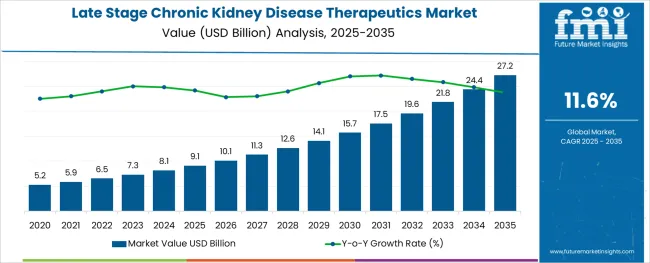
The late stage chronic kidney disease therapeutics market is experiencing steady growth due to increasing prevalence of advanced kidney disease and its associated complications. Clinical attention has been focused on managing conditions such as hyperphosphatemia, a common and serious consequence of kidney failure. Therapeutic advancements have improved patient outcomes by targeting mineral and bone disorders related to chronic kidney disease.
Healthcare providers are emphasizing early intervention and comprehensive treatment approaches to reduce morbidity. Rising healthcare infrastructure investments and greater awareness of chronic kidney disease complications have expanded treatment accessibility.
The market is poised for growth driven by novel therapies and evolving treatment protocols designed to address the complex needs of late-stage patients. Segment growth is expected to be led by calcimimetics as the preferred product type, treatment for hyperphosphatemia as the main indication, and hospital pharmacies as the primary end users.
The market is segmented by Product Type, Indication, and End Users and region. By Product Type, the market is divided into Calcimimetics, Sensipar (cinacalcet hydrochloride), Vitamin D Sterols, Nutritional/Native Vitam:in D, Vitamin D Receptor Agonists, Phosphate Binders, Calcium-Based Phosphate Binders, Aluminum-Containing Phosphate Binders, Magnesium-Containing Phosphate Binders, Renvela/Renagel, Fosrenol (lanthanum carbonate), Velphoro (sucroferric oxyhydroxide), Auryxia (ferric citrate), Potassium Binders, Resins, and Veltassa (patiromer sorbitex calcium).
In terms of Indication, the market is classified into Late Stage Chronic Kidney Disease Induced Hyperphosphatemia, Late Stage Chronic Kidney Disease Induced Hyperparathyroidism, and Late Stage Chronic Kidney Disease Induced Hyperkalemia.
Based on End Users, the market is segmented into Hospital Pharmacy, Retail Pharmacy, and Mail Order Pharmacy. Regionally, the market is classified into North America, Latin America, Western Europe, Eastern Europe, Balkan & Baltic Countries, Russia & Belarus, Central Asia, East Asia, South Asia & Pacific, and the Middle East & Africa.
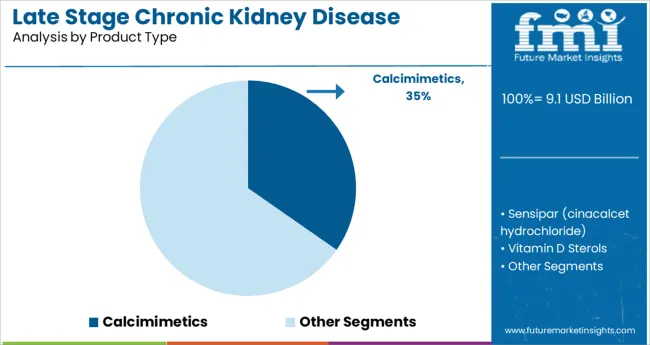
The calcimimetics segment is projected to hold 34.7% of the market revenue in 2025, positioning it as a leading product category. This segment’s growth has been driven by the effectiveness of calcimimetics in controlling parathyroid hormone levels, thereby managing mineral imbalances in late-stage chronic kidney disease patients. These agents have been favored for their ability to reduce cardiovascular risks and bone complications associated with chronic kidney disease.
The segment has benefited from advancements in drug formulations that enhance patient compliance and reduce side effects.
Calcimimetics continue to be an important part of therapeutic regimens aimed at improving clinical outcomes in advanced kidney disease.
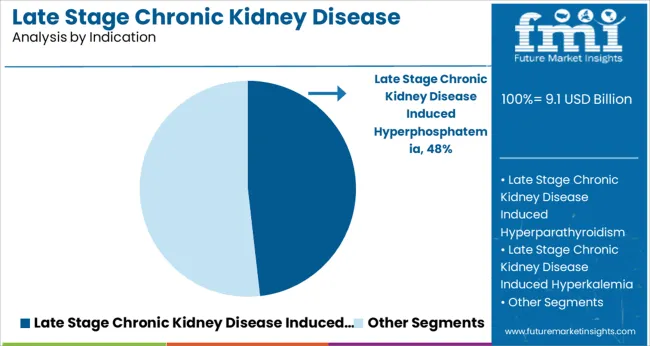
The hyperphosphatemia segment is expected to account for 48.2% of the market revenue in 2025, maintaining its position as the primary indication. This segment’s prominence is due to the high prevalence of elevated phosphate levels in patients with advanced kidney disease, which contributes to cardiovascular and bone health complications. Management of hyperphosphatemia is critical for improving patient quality of life and reducing mortality.
Therapeutic focus has been on effective phosphate control through both pharmacological and dietary interventions.
The segment has also benefited from increased screening and diagnostic efforts leading to earlier treatment initiation.
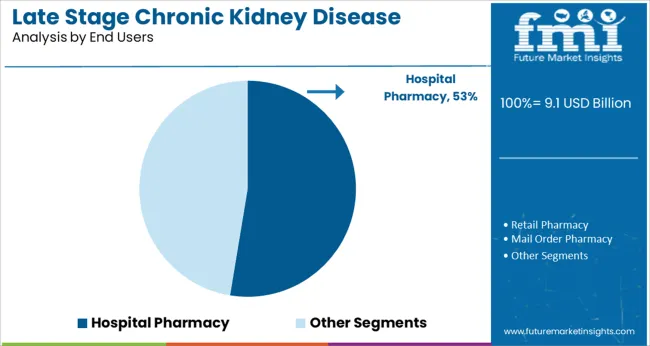
The hospital pharmacy segment is projected to represent 52.6% of the market revenue in 2025, retaining its dominance as the main end user. This segment’s growth is supported by the central role hospitals play in the management of late-stage chronic kidney disease patients, providing access to specialized therapeutics and multidisciplinary care.
Hospital pharmacies ensure the availability of critical medications and facilitate adherence to treatment protocols.
The segment has also benefited from the integration of hospital-based clinical programs focused on chronic kidney disease management. As treatment complexity increases and more patients receive care in hospital settings, the hospital pharmacy segment is expected to maintain its leading position.
Rising prevalence of chronic kidney disease (CKD) worldwide, rising awareness among people regarding the benefits of late stage chronic kidney disease therapeutics, introduction of favorable reimbursement policies for CKD treatment, higher diagnostic rates, and development of new effective therapeutics are some of the major factors expected to boost the growth of late stage chronic kidney disease therapeutics market during the forecast period.
Increasing incidence of chronic kidney disease is perhaps the major factor behind the robust expansion of late stage chronic disease therapeutics market. According to a report published in the Lancet, global prevalence of chronic kidney diseases reached around 5.2 million in 2020 and the numbers are expected to further surge during the upcoming years.
Similarly, the introduction of new advanced late stage kidney disease therapeutics along with poor access to renal replacement therapy and dialysis in developing countries is expected to favor market growth during the assessment period.
Despite its optimistic stance, the late stage chronic kidney disease therapeutics market is facing various obstacles that are restraining its growth to some extent. Some of these growth restraining factors are the delay in the diagnosis of CKD and increase in the number of kidney transplants.
Similarly, various side effects associated with late stage chronic kidney disease therapeutics is also limiting market growth.
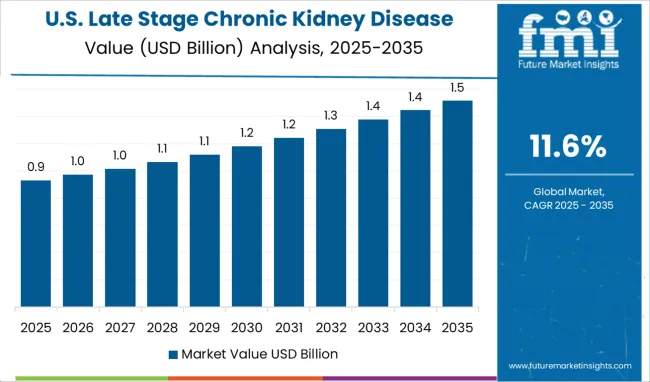
According to Future Market Insights, North America accounted for the largest share of the global late stage chronic kidney disease therapeutics market in 2024 and is projected to grow at the fastest CAGR over the forecast period. Growth in the market is attributable to the rising incidence of chronic kidney disease, availability of favorable reimbursement policies, and heavy presence of leading market players.
Demand for late stage chronic kidney disease therapeutics is particularly high across the United States due to surge in chronic kidney disease cases and easy availability of advanced therapeutics. According to the Centers for Disease Control and Prevention (CDC), around 37 million people in the United States are estimated to have chronic kidney disease.
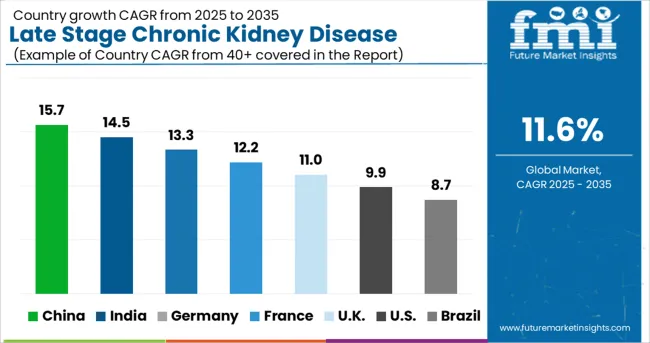
The Asia Pacific late stage chronic kidney disease therapeutics market is anticipated to grow at a considerable pace during the forecast period between 2025 and 2035, owing to the rising health awareness, growing prevalence of chronic kidney disease, and increasing government initiatives and investments to reduce the burden of chronic kidney disease.
According to the National Kidney Foundation, number of cases of kidney failure is expected to surge rapidly in developing countries, such as China and India, where the number of elderly people is increasing. This will generate lucrative growth prospects within the Asia Pacific late stage chronic kidney disease therapeutics market during the forecast period.
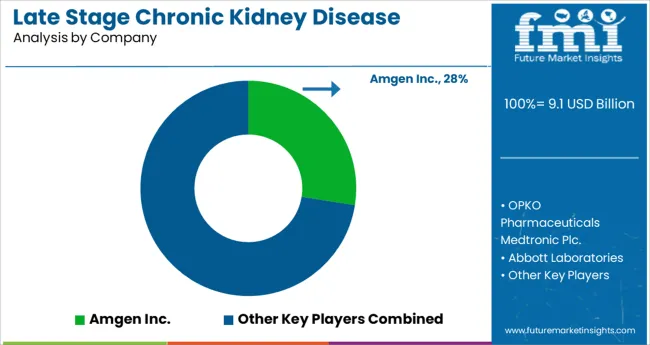
Some of the key participants present in the global late stage chronic kidney disease therapeutics market includes Amgen, Deltanoid, AbbVie, Sanofi, Ardelyx, AstraZeneca, Kyowa Hakko Kirin, Genzyme, Keryx, Spectrum, Mitsubishi Tanabe, OPKO Health, Relypsa, Shield Therapeutics, Shire, Vifor and ZS Pharma among others.
These leading players are continuously investing in research and development to introduce more effective therapeutics. Besides this, they are partnering and collaborating with dialysis centers to increase their sales and gain a competitive edge in the market.
| Report Attribute | Details |
|---|---|
| Growth Rate | CAGR of 11.6% from 2025 to 2035 |
| Base Year for Estimation | 2024 |
| Historical Data | 2020 to 2024 |
| Forecast Period | 2025 to 2035 |
| Quantitative Units | Revenue in million and CAGR from 2025 to 2035 |
| Report Coverage | Revenue Forecast, Volume Forecast, Company Ranking, Competitive Landscape, Growth Factors, Trends and Pricing Analysis |
| Segments Covered | Product Type, Indication, End Users, Region |
| Regions Covered | North America; Latin America; Western Europe; Eastern Europe; APEJ; Japan; Middle East and Africa |
| Key Countries Profiled | USA, Canada, Brazil, Argentina, Germany, UK, France, Spain, Italy, Nordics, BENELUX, Australia & New Zealand, China, India, ASEAN, GCC, South Africa |
| Key Companies Profiled | Amgen; Deltanoid; AbbVie; Sanofi; Ardelyx; AstraZeneca; Kyowa Hakko Kirin; Genzyme, Keryx; Spectrum; Mitsubishi Tanabe; OPKO Health; Relypsa; Shield Therapeutics; Shire; Vifor; ZS Pharma |
| Customization | Available Upon Request |
The global late stage chronic kidney disease therapeutics market is estimated to be valued at USD 9.1 billion in 2025.
It is projected to reach USD 27.2 billion by 2035.
The market is expected to grow at a 11.6% CAGR between 2025 and 2035.
The key product types are calcimimetics, sensipar (cinacalcet hydrochloride), vitamin d sterols, nutritional/native vitam:in d, vitamin d receptor agonists, phosphate binders, calcium-based phosphate binders, aluminum-containing phosphate binders, magnesium-containing phosphate binders, renvela/renagel, fosrenol (lanthanum carbonate), velphoro (sucroferric oxyhydroxide), auryxia (ferric citrate), potassium binders, resins and veltassa (patiromer sorbitex calcium).
late stage chronic kidney disease induced hyperphosphatemia segment is expected to dominate with a 48.2% industry share in 2025.






Full Research Suite comprises of:
Market outlook & trends analysis
Interviews & case studies
Strategic recommendations
Vendor profiles & capabilities analysis
5-year forecasts
8 regions and 60+ country-level data splits
Market segment data splits
12 months of continuous data updates
DELIVERED AS:
PDF EXCEL ONLINE
Lateral Flow Assay Component Market Size and Share Forecast Outlook 2025 to 2035
Latex Paper Backing Market Analysis - Size, Share, and Forecast Outlook 2025 to 2035
Lateral Flow Assays Market Analysis - Size, Share & Forecast 2025 to 2035
Latex Mattress Market Growth & Forecast 2025-2035
Plate Chain Elevator Market Size and Share Forecast Outlook 2025 to 2035
Platelet Shaker Market Size and Share Forecast Outlook 2025 to 2035
Plate and Frame Heat Exchanger Market Size and Share Forecast Outlook 2025 to 2035
Platelet Concentration Systems Market Size and Share Forecast Outlook 2025 to 2035
Platelet Rich Plasma Market Analysis - Size, Share, and Forecast Outlook 2025 to 2035
Plate Electrostatic Precipitator Market Size and Share Forecast Outlook 2025 to 2035
Platelet Function Test Market Report - Growth & Forecast 2025 to 2035
Plate Heat Exchanger Market Growth - Trends & Forecast 2025 to 2035
Plates Market
Slate Market
Dilated Cardiomyopathy Market Size and Share Forecast Outlook 2025 to 2035
Pilates Reformer Market Size and Share Forecast Outlook 2025 to 2035
Folate Market – Trends & Forecast 2025 to 2035
Pilates & Yoga Studios Market Trends - Growth & Outlook 2025 to 2035
Oxalate Hydrogenation Catalyst Market Size and Share Forecast Outlook 2025 to 2035
Chelated Selenium Market Analysis by Type, End-use, Distribution channel and Region through 2035

Thank you!
You will receive an email from our Business Development Manager. Please be sure to check your SPAM/JUNK folder too.
Chat With
MaRIA